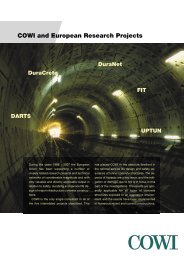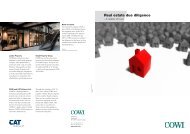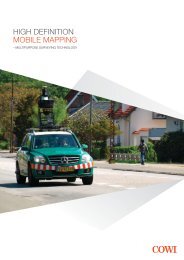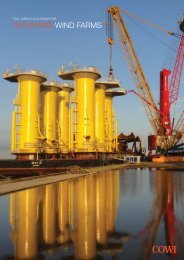Structural Health Monitoring Systems - Cowi
Structural Health Monitoring Systems - Cowi
Structural Health Monitoring Systems - Cowi
Create successful ePaper yourself
Turn your PDF publications into a flip-book with our unique Google optimized e-Paper software.
<strong>Structural</strong> health monitoring system<br />
Class<br />
1 2 3 4<br />
ENVIRONMENTAL EFFECTS*<br />
Air temperature SL SL SL SL<br />
Air and surface humidity L SL SL<br />
Precipitation SL SL<br />
Pavement water veil SL SL<br />
Ice formation SL SL<br />
Athmospheric pressure<br />
SL<br />
Solar radiation<br />
SL<br />
LOAD EFFECTS*<br />
Wind Tower top & girder level L L SL SL<br />
Traffic Load and traffic count SL SL SL<br />
<strong>Structural</strong> temperature Girder, tower and cables L SL<br />
Seismic/tectonic activity Seismic activity and tsunami SL SL<br />
Correlation at midspan<br />
L<br />
STRUCTURAL RESPONCE<br />
Corrosion Concrete reinforcement splash zone SL SL SL SL<br />
Joint relative displacement SL SL SL SL<br />
Special element responce L SL SL<br />
Stress/Strain Fatigue orthotropic deck L L SL<br />
cable anchorage L L<br />
Dynamic motion Global bridge behaviour L L<br />
Cables L L<br />
Concrete creep In situ concrete SL SL<br />
Stress/Strain Global bridge sectional forces L<br />
Global structural positioning<br />
L<br />
GEOTECHNICAL RESPONCE<br />
Ground settlement and inclination SL SL SL<br />
Ground pressure L L<br />
Interstitial pressure L L<br />
Special element responce SL SL<br />
* eventually supplied by external weather station / traffic control center / Seismic-tectonic measurement station<br />
class<br />
1 Important for all bridges<br />
2 Necessary for minimum maintenance planning<br />
3 Necessary for an optimal health monitoring and traffic control<br />
4 Nice to know, may be monitored if problem arises<br />
Bridge size<br />
S: Short span<br />
L: Long span<br />
Making it easier for a single<br />
expert to advice on several bridges<br />
simultaneously.<br />
• User interfaces can vary depending<br />
on need. The same data can be<br />
visualized on a monitoring<br />
computer or on the mobile phone<br />
of the bridge manager.<br />
• Data analyses is separated from<br />
its consumption thus enabling<br />
usage of optimised platforms for<br />
each need.<br />
7<br />
The monitoring and control activity<br />
is necessary in order to:<br />
• to check the physical-environment,<br />
structural and traffic<br />
conditions of the Bridge<br />
• to identify, verify and notify<br />
anomalous events and situations,<br />
such as trespassing of attention<br />
and/or criticality thresholds in the<br />
monitored area<br />
• to constitute the infrastructure’s<br />
history, through data collection<br />
and elaboration<br />
• to constitute the data base<br />
necessary for the infrastructure’s<br />
management and maintenance<br />
• to visualize the status of the<br />
systems on displays in the Control<br />
Room<br />
• to assist the Operator in his<br />
management of the Bridge and the<br />
traffic on the Bridge<br />
The creation of a historical file of<br />
collected data will support the<br />
development of maintenance and<br />
management strategies, as well as<br />
the planning of short, medium and<br />
long term interventions.<br />
Each monitoring device (equipment,<br />
system) will be located,<br />
addressable and able to transmit/<br />
receive data to/from a centralized<br />
database server.<br />
<strong>Monitoring</strong> Parameters<br />
Depending on the chosen monitoring<br />
strategy, the bridge type and the<br />
environment it is placed in the<br />
parameters to be monitored must be<br />
optimised.<br />
The shown table summarises the<br />
potential parameters to include.<br />
Deferens’s for short and long span<br />
bridges are shown together with the<br />
importance of the monitoring<br />
parameters.<br />
User Interface<br />
The trend in all monitoring applications<br />
is towards use of universal and<br />
standards based web interface. The<br />
clear advantages of this approach<br />
are:<br />
• Number of simultaneous users/<br />
viewers is limited by server and<br />
bandwidth capacity only.<br />
• Bridge personnel can easily relay<br />
questions to an off-site expert.<br />
The UI (User Interface) has to be<br />
extremely simple as the users are<br />
often not as skilled or motivated as<br />
people were during construction.<br />
Even very small user interface<br />
problems when repeated day after<br />
day year after year get to be<br />
intolerable. The interface must offer<br />
only the absolutely necessary<br />
numbers and try hard not to<br />
overwhelm the user with unnecessary<br />
data. Another role of the<br />
monitoring system and its UI is<br />
when something unexpected and<br />
sudden happens. In this situation<br />
the user interface must give only the<br />
most critical information, it must<br />
not limit the users options, but it<br />
must do all it can to minimize the<br />
total load on the user. The UI will<br />
send automatic alerts to pre-defined<br />
persons, both with SMS or other<br />
means, and free the person on the<br />
spot to do the deciding what to do.

















